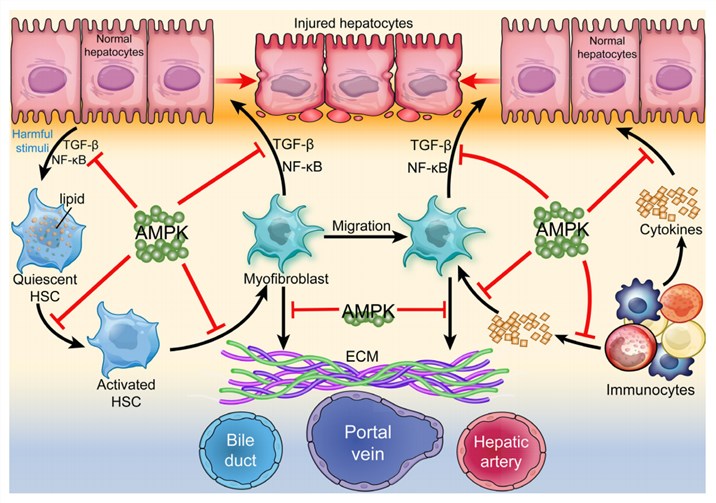NASH Target Development Service for AMPK Activators
5' adenosine monophosphate-activated protein kinase (AMPK) plays a key role in integrating metabolic pathways. Activation of AMPK can reverse some of the metabolic disorders associated with the metabolic syndrome, including non-alcoholic steatohepatitis (NASH). Therefore, Creative Biolabs is dedicated to offering an attractive therapeutic strategy for NASH and associated metabolic disorders through AMPK activators development.
Background of AMPK Activators
Dysregulation of hepatic lipid and cholesterol metabolism is a significant contributor to cardiometabolic health, resulting in excessive liver lipid accumulation and ultimately non-alcoholic steatohepatitis (NASH). It often causes insulin resistance and chronic inflammation, which increases the risk of progressive liver disease with fibrosis, cirrhosis and potentially, hepatocellular carcinoma. AMPKs are key regulators of hepatic lipid metabolism and can be activated by multiple activators in the liver. By reducing de novo lipogenesis, it is expected that activation of liver AMPK can slow down the progression of non-alcoholic fatty liver disease and reduce the risk of related complications such as NASH, cirrhosis and hepatocellular carcinoma. Liver-specific activation of AMPK by activators prevents lipid accumulation and triglyceride accumulation, indicating AMPK activators have implications for the therapeutic potential of targeting hepatic AMPK. Therefore, AMPK activators might be an attractive therapeutic strategy for preventing the progression of NASH and subsequent development of associated complications.
AMPK Activators for NASH
Dysregulation of hepatic lipid and cholesterol metabolism is a significant contributor to cardiometabolic health, resulting in excessive liver lipid accumulation and ultimately non-alcoholic steatohepatitis (NASH). It often causes insulin resistance and chronic inflammation, which increases the risk of progressive liver disease with fibrosis, cirrhosis and potentially, hepatocellular carcinoma. AMPKs are key regulators of hepatic lipid metabolism and can be activated by multiple activators in the liver. By reducing de novo lipogenesis, it is expected that activation of liver AMPK can slow down the progression of non-alcoholic fatty liver disease and reduce the risk of related complications such as NASH, cirrhosis and hepatocellular carcinoma. Liver-specific activation of AMPK by activators prevents lipid accumulation and triglyceride accumulation, indicating AMPK activators have implications for the therapeutic potential of targeting hepatic AMPK. Therefore, AMPK activators might be an attractive therapeutic strategy for preventing the progression of NASH and subsequent development of associated complications.
 Fig.1 Regulation of AMPK in hepatic fibrogenesis. (Liang, 2017)
Fig.1 Regulation of AMPK in hepatic fibrogenesis. (Liang, 2017)
Our Services about NASH
As a first class and the undisputed service provider of drug discovery, Creative Biolabs has a "one-stop" drug development service platform, which combines its own advantages to provide customers with a range of technical services about NASH, which include but not limited to:
- Biomarkers for NASH Diagnosis
- Target Discovery and Therapeutic Strategies
- Preclinical Models of NASH
In addition to NASH-related services, Creative Biolabs also provides drug discovery&design services (including Hit to Lead, Lead Optimization, IND-Enabling, Target Identification, and Validation, Hit identification) and antibody development services (including Phage Display & Antibody Library Services, Antibody Analysis Services, Antibody Engineering Services) based on other diseases. Our service platform is a cost-effective and effective option for you to accelerate the development of drug targets. If you need any services about NASH, please feel free to contact us.
Reference
- Liang, Z.; et al. AMPK: a novel target for treating hepatic fibrosis. Oncotarget. 2017, 8(37): 62780. Distributed under Open Access license CC BY 4.0, without modification.
 For Research Use Only.
For Research Use Only.